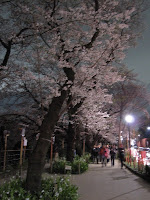
More than 30 years has passed since Akihabara became one of Tokyo’s must-see places for foreign tourists.
It has not changed that the town is Tokyo’s electronic mecca. However, many things – stores, streets, visitors, and the town’s atmosphere – have been changing.
 The electronic shop streets are in the west of Akihabara station. There are various shops. Some shops sell consumer electronic goods and some shops sell electronic parts. Some shops are large and others are small. New shops stand next to old shops.
The electronic shop streets are in the west of Akihabara station. There are various shops. Some shops sell consumer electronic goods and some shops sell electronic parts. Some shops are large and others are small. New shops stand next to old shops.
There are also stores of computer games and Manga. I saw cosplay (costume play) girls (in comic style) in the streets. A also found Sumo wrestlers walking in the street.
The town must be more messy and interesting if I come here in the weekend (today is Monday).
 A large Yodobashi Akiba building stands in the east area of the station. Electronic stores as well as restaurants and other shops are in it. It was open in 2005.
A large Yodobashi Akiba building stands in the east area of the station. Electronic stores as well as restaurants and other shops are in it. It was open in 2005.
It has not changed that the town is Tokyo’s electronic mecca. However, many things – stores, streets, visitors, and the town’s atmosphere – have been changing.
 The electronic shop streets are in the west of Akihabara station. There are various shops. Some shops sell consumer electronic goods and some shops sell electronic parts. Some shops are large and others are small. New shops stand next to old shops.
The electronic shop streets are in the west of Akihabara station. There are various shops. Some shops sell consumer electronic goods and some shops sell electronic parts. Some shops are large and others are small. New shops stand next to old shops.There are also stores of computer games and Manga. I saw cosplay (costume play) girls (in comic style) in the streets. A also found Sumo wrestlers walking in the street.
The town must be more messy and interesting if I come here in the weekend (today is Monday).
 A large Yodobashi Akiba building stands in the east area of the station. Electronic stores as well as restaurants and other shops are in it. It was open in 2005.
A large Yodobashi Akiba building stands in the east area of the station. Electronic stores as well as restaurants and other shops are in it. It was open in 2005. 










































